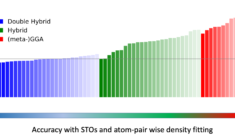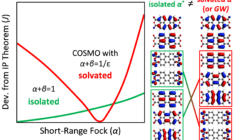Exchange-correlation (xc) functionals
Our molecular and periodic density functional theory (DFT) codes ADF and BAND can use many different density functionals. See the ADF and BAND manuals for the latest details on available exchange-correlation functionals and compatibility.
There are four types of general purpose xc functionals: the local-density approximation (LDA), Generalized Gradient Approximation (GGA), hybrid density functionals (hybrids), and meta-GGA (mGGA). These DFT functionals depend on local information, in the sense that the value of the potential at a given point depends only on the values of the density n(r), the gradient of the density ∇n(r) and the kinetic energy density τ(r). The exact exchange part of the hybrids can be further split into short and long-range parts: range-separated hybrids, or used with mGGAs: meta-hybrids.
LDA: Exc = Exc [n(r)]
GGA: Exc = Exc [n(r),∇n(r)]
Hybrid: Exc = axExx + Exc (GGA)[n(r),∇n(r)]
mGGA: Exc = Exc [n(r),∇n(r), ∇2n(r), τ(r)]
Besides native implementation of density functionals, both ADF and BAND have been interfaced to libxc 5.0, an extensive library of xc functionals.
Range separated hybrids (RSH)
ADF can use Yukawa switching for RSH xcfun, which enables optimizing the switching parameter – see also the advanced tutorial: Tuning the range separation in LC-wPBE for organic electronics. The RSHs in libxc can not be optimized. BAND can use short-range hybrids (HSE03, HSE06) for periodic system.
Double hybrids, RPA, G0W0, qsGW
A very efficient single point energy implementation of MP2 and a class of double hybrids (DOD-double-hybrid functionals) have been implemented in ADF. Similarly, fast RPA and GW approaches are available. See recommendations for double hybrids and recommendations for qsGW.
Dispersion corrections
For some functionals dispersion corrections are already included by construction (quite a few double-hybrids, some Minnesota functionals). For others you should consider including D3(BJ) or D4(EEQ) dispersion corrections. Alternative dispersion corrections are dDsC and DFT-MBD.
Model potentials
Model potentials are specialized xc potentials which don’t have an energy expression. They usually have the correct asymptotic behavior and can provide much better results for spectroscopic properties and band structures (see benchmark). Most notable examples include:
ADF: LB94, SAOP
BAND: GLLB-sc, TB-mBJ, KTB-mBJ, Polarization functional, GGA+U, DFT-1/2
Recommendations for DFT functionals
Unfortunately the universal DFT functional is not yet found, and each type of problem you would like to tackle with DFT requires a bit of literature research and/or benchmarking. We suggest to do a literature check to see if people have benchmarked the properties of interest for similar systems. Doing a simple set of test calculations on a smaller system and comparing to experiments can also help you make better decisions.
Geometries are usually quite good with GGAs, which are much faster in ADF and BAND than mGGAs or hybrids.
For quite a few dense 3D periodic systems, the fastest xc functional (LDA) may be yield quite accurate ion positions and lattice vectors.
Using a DFTB Hessian (e.g. in the Details -> Geometry panel in the GUI choose ‘Calculate With Fast Engine’) can considerably speed up your ADF and BAND geometry optimizations and transition state searches.
For energies you may prefer mGGAs such as SCAN or MN15-L, hybrids, or a double hybrid (see recommendations).
For spectroscopic properties such as NMR (FAQ), EPR, UV/VIS (FAQ), XPS, XANES you may prefer hybrids such as PBE0 or mGGAs. It is also worthwhile considering model potentials. For TADF emitters, tuned RSH are often used for more accurate S1/T1 energies. CV-DFT with a GGA may be an alternative option worth exploring.
Available exchange-correlation functionals
We try to be as complete as possible, although the list is probably not exhaustive. Not all DFT functionals may be available for each property and calculation option (e.g. TDDFT, spin-orbit coupling, open-shell, COSMO, …). Contact us when in doubt.
ADF exchange-correlation functionals
XC functionals which need to be specified in a libxc block are italicized. See also the ADF manual.
| LDA | Xonly, Xalpha, VWN, PW92, Teter93 |
| GGA | exchange-correlation: BP86, PW91, mPW, PBE, RPBE, revPBE, mPBE, PBEsol, HTBS, BLYP, OLYP, OPBE, BEE, XLYP, SSB-D, S12g, KT1, KT2, AM05, BCGP, B97-GGA1, B97-K, EDF1, GAM, HCTH-93, HCTH-120, HCTH-147, HCTH-407, HCTH-407P, HCTH-P14, PBEINT, MOHLYP, MOHLYP2, N12, PBEINT, Q2D, SOGGA, SOGGA11, TH-FL, TH-FC, TH-FCFO, TH-FCO, TH1, TH2, TH3, TH4, XPBE, HLE16 exchange: Becke, PW86x, PW91x, mPWx, PBEx, RPBEx, PBEsolx, HTBSx, OPTX, BEEx correlation: Perdew , PBEc, PBEsolc, PW91c, LYP |
| hybrid | B3LYP, B3LYP*, B1LYP, KMLYP, O3LYP, X3LYP, BHandH, BHandHLYP, B1PW91, mPW1PW, mPW1K, PBE0, OPBE0, S12h, ABPE0, APF, B1PW91, B3LYP-MCM1, B3LYP-MCM2, B1WC, B3LYP5, B3LYPS, B3P86, B3PW91, B97, B97-1, B971-1P, B97-2, B97-3, B97-K, BLYP35, CAP0, HAPBE, EDF2, MB3LYP-RC04, MPW3LYP, MPW3PW, MPWLYP1M, O3LYP, PBE0-13, REVB3LYP, REVPBE, SB98-1A, SB98-1B, SB98-1C, SB98-2A, SB98-2B, SB98-2C, SOGGA11-X, X3LYP range-separated: CAMY-B3LYP, combine LDA (VWN5, X-ALPHA PW92), GGA exchange: Becke88, PBEX, OPTX, PW91X, mPW, revPBEX, GGA correlation: LYP, Perdew86, PBEC, or MetaGGA: TPSS, M06L, B95, CAM-B3LYP, CAM-BLYP, CAM-PBE, CAM-QTP-02, HJS-PBE, HJS-PBESOL, HJS-B97X, HSE03, HSE06, LRC_WPBE, LRC_WPBEH, LCY-BLYP, LCY-PBE, M11, MN12-SX, N12-SX, TUNED-CAM-B3LYP, WB97, WB97X, WB97X-D |
| mGGA | M06-L, TPSS, revTPSS, SSB-D, MVS, MS0, MS1, MS2, SCAN, TASKxc, M11-L, MN12-L, MN15-L, PKZB, HLE17 |
| metahybrid | M06, M06-2X, M06-HF, TPSSh, B86B95, B88B95, BB1K, M05, M05-2X, M08-HX, M08-SO, MPW1B95, MPWB1K, MS2H, MVSH, PW6B95, PW86B95, PWB6K, REVTPSSH, X1B95, XB1K |
| double hybrids | DOD: SOS1-PBE-QIDH, rev-DOD-BLYP, rev-DOD-BLYP-D4, rev-DOD-PBE, rev-DOD-PBE-4, rev-DOD-PBEP86, rev-DOD-PBEP86-D4, DOD-SCAN, rev-DOD-SCAN-D4 Standard: B2PLYP, B2PIPLYP, ROB2PLYP, B2TPLYP, B2GPPLYP, B2KPLYP, B2NCPLYP, mPW2PLYP, mPW2KPLYP, mPW2NCPLYP, DH-BLYP, PBE0-DH, PBE-QIDH, LS1-DH, PBE0-2, LS1-TPSS, DS1-TPSS Spin-component-scaled DSD-BLYP, rev-DSD-BLYP-D4, DSD-PBEP86, rev-DSD-PBEP86, rev-DSD-PBEP86-D4, DSD-PBE, rev-DSD-PBE, rev-DSD-PBE-D4, rev-DSD-SCAN-D4, SD-SCAN69 |
| model & special | LB94, GRAC, SAOP, OEP |
BAND exchange-correlation functionals
XC functionals which need to be specified in a libxc block are italicized. See also the BAND manual. Native functionals can usually also be defined as libxc functionals, which is recommended for analytical lattice gradients.
| LDA | Xonly, Xalpha, VWN, Stoll, PW92, Teter93 |
| GGA | exchange-correlation: BP86, PW91, mPW, PBE, RPBE, revPBE, mPBE, PBEsol, HTBS, BLYP, OLYP, OPBE, BEE, XLYP, SSB-D, S12g, KT1, KT2, AM05, BCGP, B97-GGA1, B97-K, EDF1, GAM, HCTH-93, HCTH-120, HCTH-147, HCTH-407, HCTH-407P, HCTH-P14, PBEINT, MOHLYP, MOHLYP2, N12, PBEINT, Q2D, SOGGA, SOGGA11, TH-FL, TH-FC, TH-FCFO, TH-FCO, TH1, TH2, TH3, TH4, XPBE, HLE16 exchange: Becke, PW86x, PW91x, mPWx, PBEx, RPBEx, PBEsolx, HTBSx, OPTX, BEEx correlation: Perdew , PBEc, PBEsolc, PW91c, LYP |
| (RS) hybrid | B3LYP, B3LYP*, B1LYP, KMLYP, O3LYP, X3LYP, BHandH, BHandHLYP, B1PW91, mPW1PW, mPW1K, PBE0, OPBE0, S12h, ABPE0, APF, B1PW91, B3LYP-MCM1, B3LYP-MCM2, B1WC, B3LYP5, B3LYPS, B3P86, B3PW91, B97, B97-1, B971-1P, B97-2, B97-3, B97-K, BLYP35, CAP0, HAPBE, EDF2, MB3LYP-RC04, MPW3LYP, MPW3PW, MPWLYP1M, O3LYP, PBE0-13, REVB3LYP, REVPBE, SB98-1A, SB98-1B, SB98-1C, SB98-2A, SB98-2B, SB98-2C, SOGGA11-X, X3LYP range-separated: HSE03, HSE06, HJS-B97X, HJS-PBE, HJS-PBESOL |
| metaGGA | M06-L, TPSS, revTPSS, SSB-D, MVS, MS0, MS1, MS2, SCAN, TASKxc, M11-L, MN12-L, MN15-L, PKZB, HLE17 |
| model & special | GLLB-sc, BGLLB-VWN, BGLLB-VWN TB-mBJ, KTB-mBJ, JTS-mTB-mBJ, GGA+U, DFT-1/2, OEP, Polarization functional (Berger2015), Vignale-Kohn |

